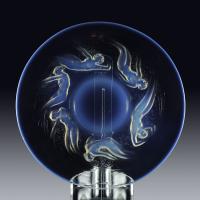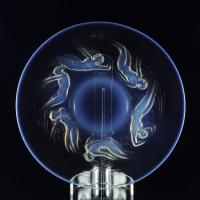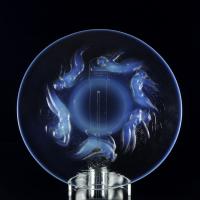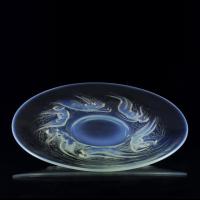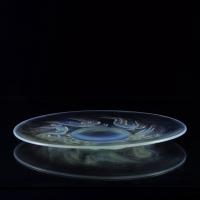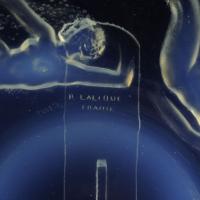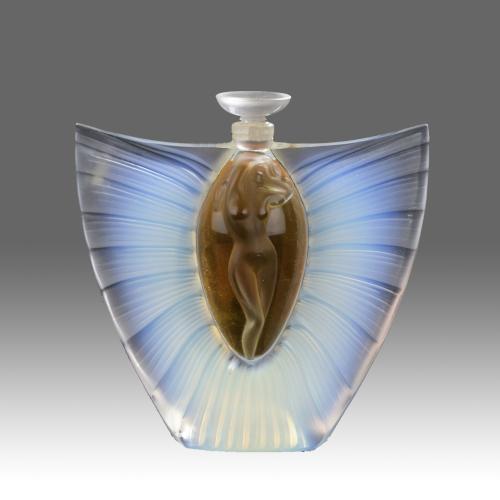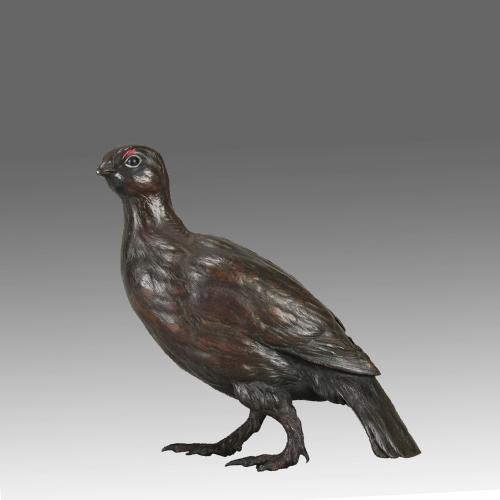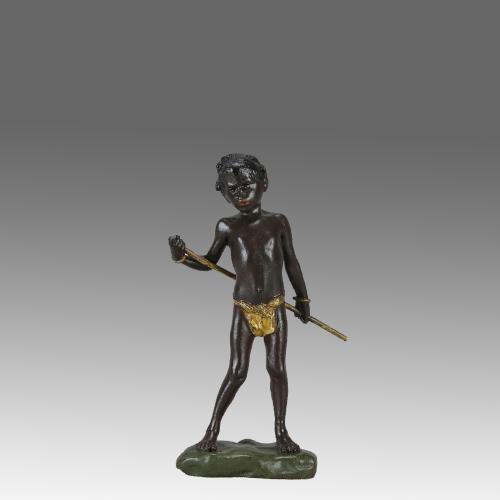
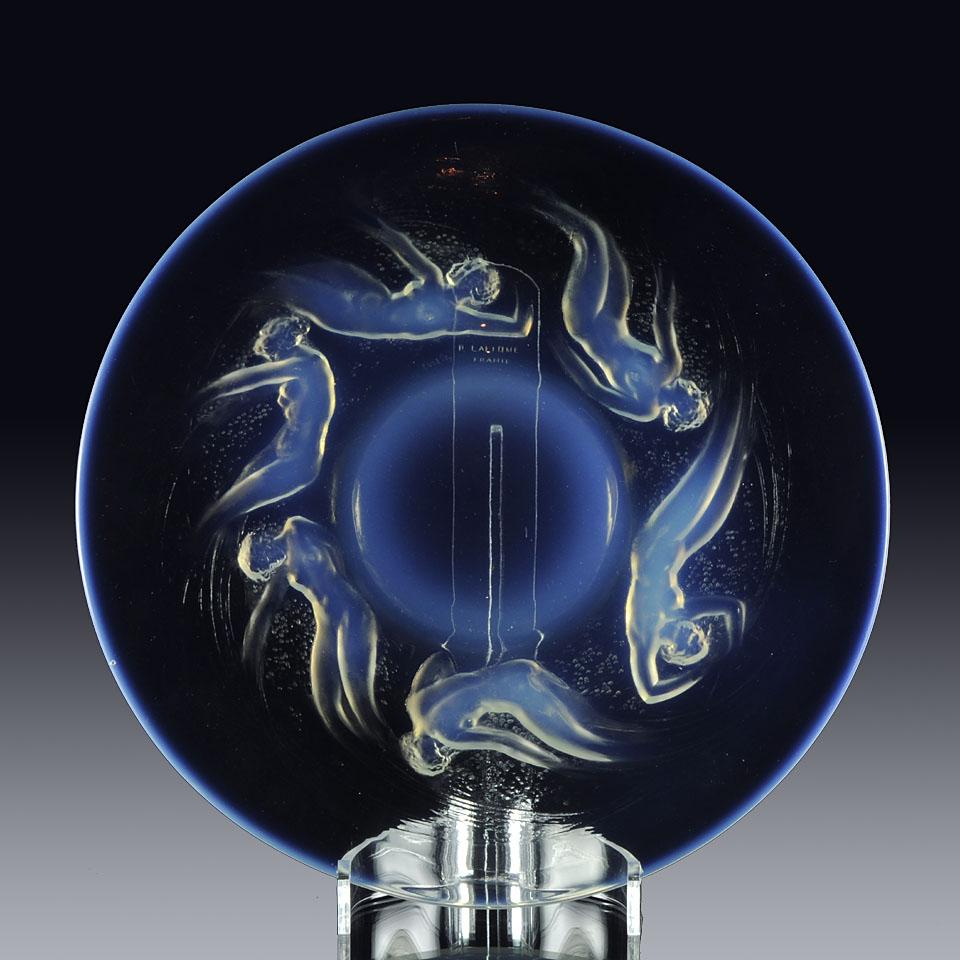
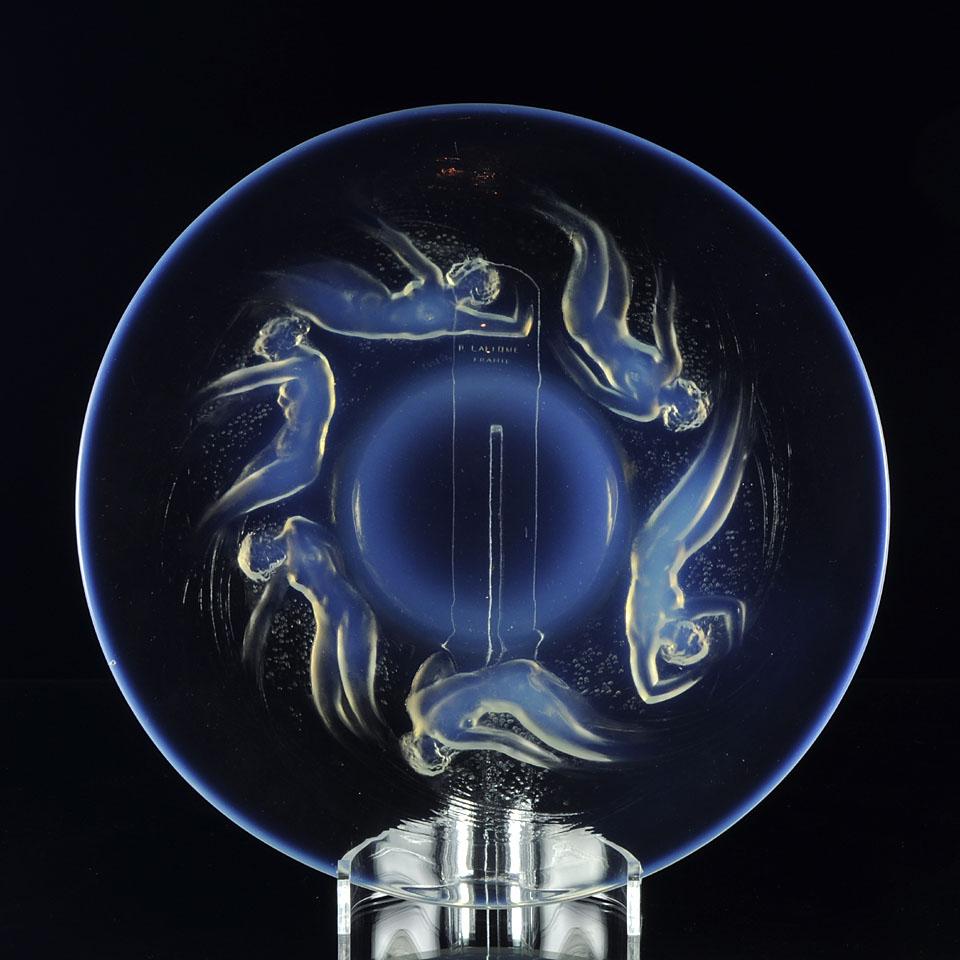
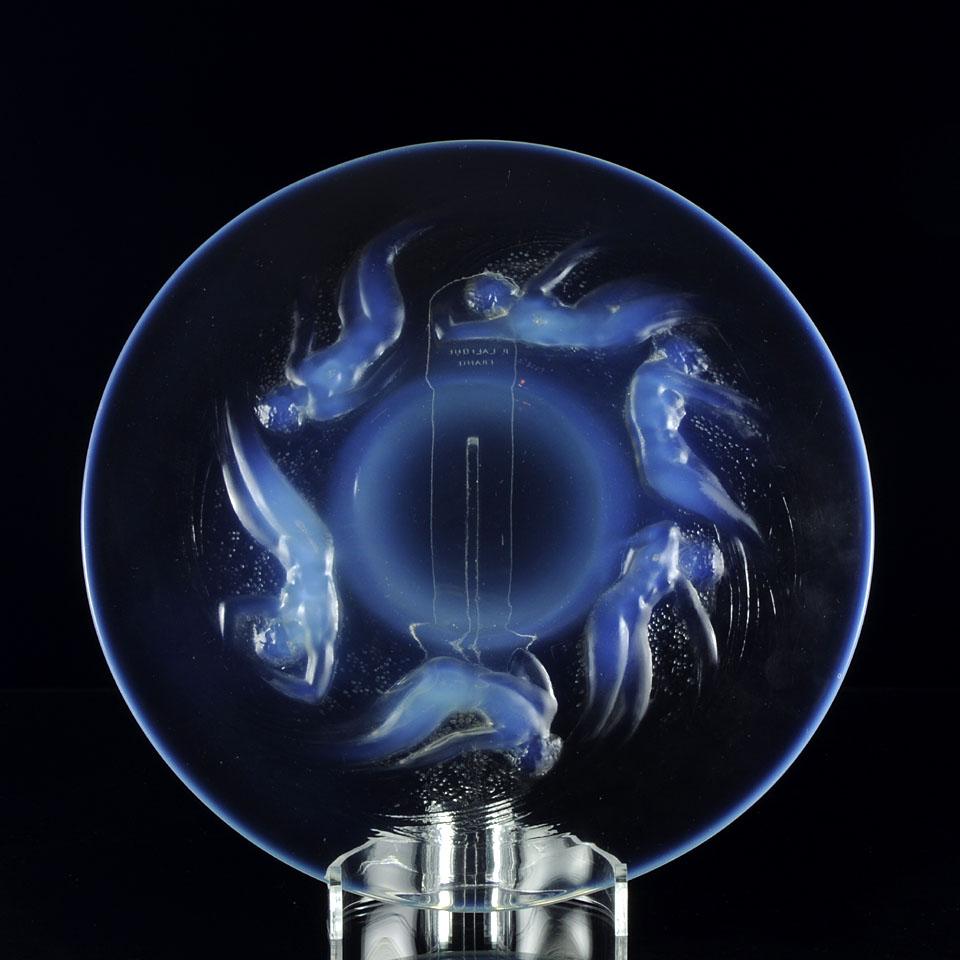
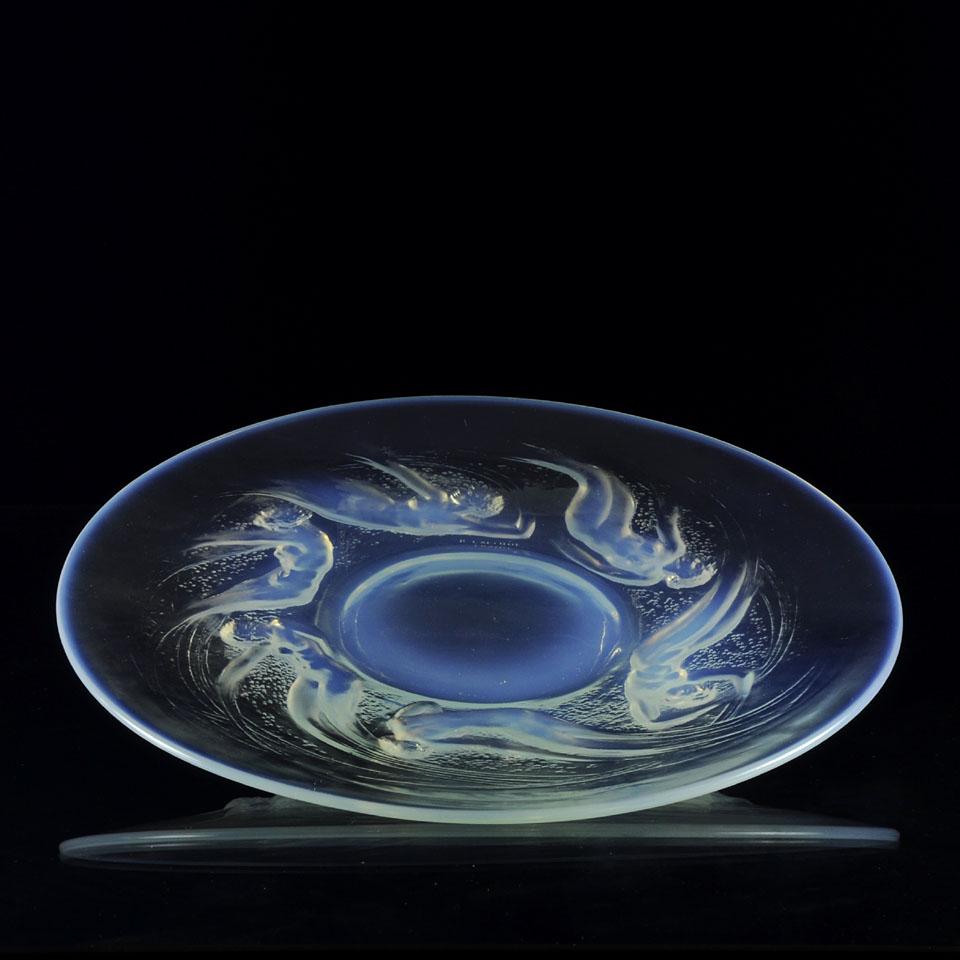
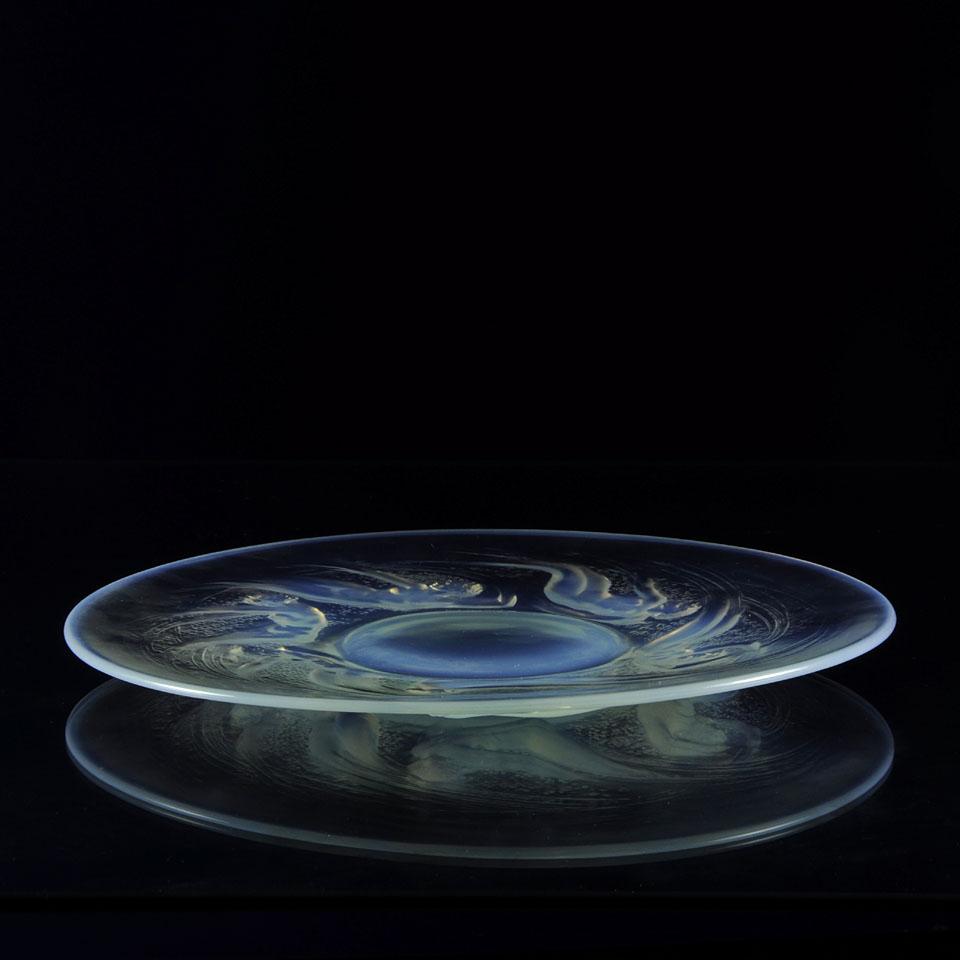
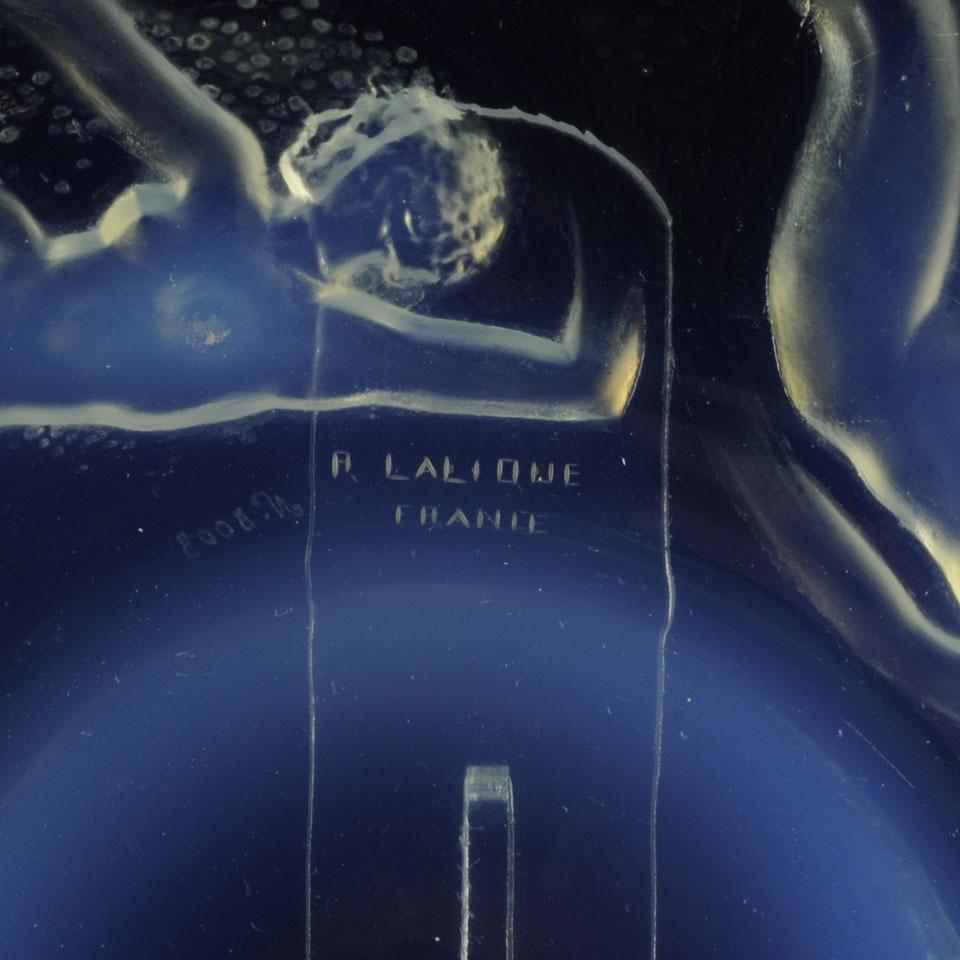

Price
£2250.00This object is eligible for a Certificate of BADA Provenance
The BADA Standard
- Since 1918, BADA has been the leading association for the antiques and fine art trade
- Members are elected for their knowledge, integrity and quality of stock
- Our clients are protected by BADA’s code of conduct
- Our dealers’ membership is reviewed and renewed annually
- Bada.org is a non-profit site: clients deal directly with members and they pay no hidden fees
A highly visual and attractive Art Deco glass plate with raised pattern of swirling sea nymphs exhibiting excellent deep sky blue opalescence and complimented with fine hand finished detail, signed R. Lalique.
Ondines
Catalogue Number: 3003
Signature identification: “R. Lalique France” wheel cut top of centre of base
Date introduced: August, 1921
Dimensions: 27.5 cm Diam
Felix Marchilac Catalogue Raisonné Page 699
ADDITIONAL INFORMATION
Diameter: 27.5 cm
Condition: Excellent Original Condition
Circa: 1925
Materials: Opalescent Glass
Book Ref: R.Lalique – Catalogue Raisonné by Felix Marcilhac
Page No. 699
SKU: 5771
ABOUT
1860 | Birth of René Lalique
René Lalique was born in Aÿ-en-Champagne in the Marne region of France. Some years later, the Lalique family moved to Paris but continued to spend holidays in Aÿ. René remained deeply attached to his birthplace throughout his life.
1885 | The first Parisian workshop
Following the death of his father, René became an apprentice to craftsman and jeweller Louis Aucoc. It was during this time that he learned jewellery-making techniques, while attending classes at the École des Arts Décoratifs in Paris. He then left for England where he continued his studies for two more years.
In 1885, after gaining recognition as an independent designer for some of the great jewellery Houses such as Jacta, Cartier and Boucheron, René Lalique took over the workshop of jeweller Jules Destape on Place Gaillon in Paris.
“At the time, I didn’t know of any jewellery designers and at last, here we have one!”
Alphonse Fouquet, a prominent 19th-century Parisian jeweller
1888 | First ornaments inspired by Antiquity and Japonism
In 1887, Lalique set up business on Rue du Quatre-Septembre. As early as 1888 he designed his first parures in finely-wrought gold inspired by Antiquity and Japonism, and broke with jewellery-making tradition by including innovative materials in his pieces. At the time, originality and creativity had been abandoned in favour of ornate and lavish styles with an abundance of precious stones. He made the materials he used central to his designs. He chose them for their power, light and colour, whether they were precious or not. He combined gold and gemstones with semi-precious stones, mother-of-pearl, ivory and horn, in addition to enamel and glass.
In 1888, René Lalique registered his “RL” stamp and engraved the unique pieces created in his workshop with these letters.
“For a number of years he concentrated exclusively on fine jewellery, on bright and lustrous parures sparkling with diamonds.”
Henri Vever, French jeweller, author and collector
1890 | The transition from jewellery to enamel and glass
René Lalique’s work had gained wide-spread popularity.
He now opened his third workshop at 20, Rue Thérèse in Paris. His first experiments and designs using glass date from this era. René already used enamel and glass, side-by-side with gold, opals, diamonds, pearls or amethysts, to embellish his jewellery.
1900 | The Paris Exposition Universelle
Over the next decade, René Lalique forged his reputation. He won competitions, exhibited his work and created jewellery for well-known entertainers such as actress Sarah Bernhardt. His desire to “create something that had never been seen before” earned him the accolade of “inventor of modern jewellery”. He revolutionised jewellery styles of the period, becoming a favourite with leading socialites, and was admired by the most distinguished of his fellow-jewellers. His work was commissioned by the great courts and collected by the world’s wealthy.
So when René Lalique took part in the 1900 Great Exhibition in Paris, it was the crowning moment of René Lalique’s career as a jeweller. It was that same year he was also named Officer of the French Legion d’Honneur.
“He designed and crafted jewellery for leading actresses […] he sought out striking shapes and colours and unusual designs to decorate a headpiece for the character of Théodora.”
Gustave Geffroy, French journalist, art critic, historian and novelist
1907 | The start of a partnership with François Coty
In 1905 René Lalique opened a shop at 24, Place Vendôme, where he exhibited not only his jewellery but also the glass objects crafted in his workshop at his estate in Clairefontaine, near Rambouillet. Perfumer François Coty was so impressed by René’s designs that he asked him to put his talent to work for the perfume industry. Their collaboration had begun! Their work together revolutionised the perfume industry and made it possible for the first time to offer perfumes in attractive bottles at affordable prices. From then on, René worked increasingly on designs for the perfume sector, finally devoting himself entirely to more industrial techniques of glass production.
René Lalique, Art Nouveau master jeweller, was to become an Art Deco master glassmaker.
1921 | Founding the Alsace glassworks
René had now devoted himself to glassmaking for several years. His quest for a suitable location to produce glassware and a qualified workforce led him to Alsace. He founded the Verrerie d’Alsace glassworks at Wingen-sur-Moder in Alsace, at the heart of a region with a strong and historic glassmaking tradition. This is now the world’s only Lalique factory.
1925 | International Exposition of Modern Industrial and Decorative Arts
René Lalique participated in numerous architectural projects. The 1925 International Exposition of Modern Industrial and Decorative Arts in Paris marked the climax of René’s career as glassmaker, and a triumph for the Art Deco movement. His techniques with glass gave rise to a style that was essentially expressed through the contrast between clear and frosted glass. He sometimes added a patina or enamel or used stained glass.
“Glass is a marvellous material.”
1929 | Decorating the Côte d’Azur Pullman Express train
When luxury was involved, René Lalique’s name was right alongside. He was inundated with commissions and undertook some large-scale interior design projects. René was chosen to undertake the decoration of the Côte d’Azur Pullman Express carriages.
1935 | Fitting out the Normandie luxury liner
René Lalique was commissioned for a series of high-profile projects. These included decorating the famous fashion designer Madeleine Vionnet’s haute couture salons, designing glass doors for Prince Yasuhiko Asaka’s residence in Tokyo and creating the fountain which for a time decorated the Galerie des Champs-Elysées in Paris. He then participated in the interior design of the vast first-class dining room of the luxury liner Normandie. He designed lighting columns and chandeliers for this colossus of the seas.
1935 was also the year in which René Lalique opened his shop at 11 Rue Royale in Paris.
1945 | Death of René Lalique
After the death of René Lalique. His son Marc took over as head of the business. He was to bring Lalique into the age of crystal.
2008. Since 2010, Cristal Lalique has been wholly owned by Art & Fragrance.
Stock number
5771The BADA Standard
- Since 1918, BADA has been the leading association for the antiques and fine art trade
- Members are elected for their knowledge, integrity and quality of stock
- Our clients are protected by BADA’s code of conduct
- Our dealers’ membership is reviewed and renewed annually
- Bada.org is a non-profit site: clients deal directly with members and they pay no hidden fees


